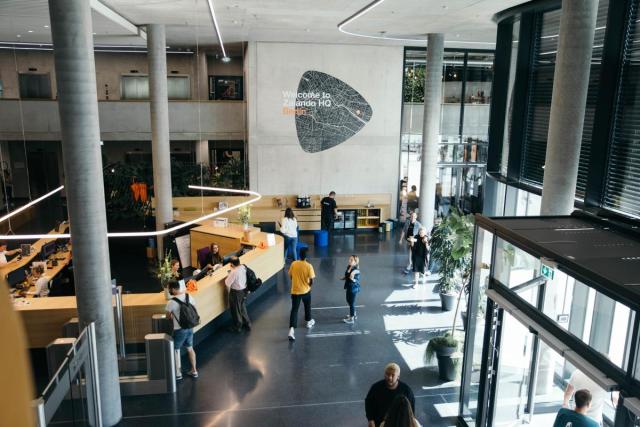The pandemic turbocharged business at Zalando, one of Europe’s largest online fashion retailers – and double-digit increases across the board in 2020 have emboldened the company.
Zalando said Wednesday it has plans to account for more than 10 percent of the continent’s entire fashion market, worth 450 billion euros, in the longer term.
“2020 has been a year like no other,” Robert Gentz, Zalando’s co-chief executive officer, said in a statement.
As customers, brands and even smaller retailers were forced online. Zalando’s revenues rose 29.6 percent to reach 2.57 billion euros in Q4. Over the course of 2020 they increased 23.1 percent to 8 billion euros.
The Berlin-based platform’s gross merchandise value, or GMV, rose 38 percent in the final three months of 2020 to 3.5 billion euros. Zalando has argued that, as it becomes more of a platform, GMV is a better indicator of its success. This figure is usually higher than revenue because that only includes commissions and service fees from partner brands, as opposed to the amount of stock Zalando actually moved as a platform.
Over the course of 2020, Zalando’s GMV increased 30.4 percent and totaled 10.7 billion euros worth of product sold. The platform now offers around 900,000 different articles from 4,000 brands.

Related Gallery
Fall 2021 Trend: Knitwear
The company predicted 2021 revenues would grow between 24 and 29 percent in 2021, and would hit between 9.9 and 10.3 billion euros.
Following an extraordinarily strong start to the year 2021 with expected GMV growth of around 50 peacent in the first quarter, Zalando also forecast that it would move between 27 and 32 percent more product over all of 2021, totaling between 13.6 and 14.1 billion euros. This was above analysts’ expectations.
But it was the change in sales in various territories that really seem to cement Zalando’s plan to become Europe’s “starting point for fashion”.
“Ultimately we need customers to think when a brand, or product, or a size, is not available on Zalando, it probably does not exist,” Gentz emphasized.
Over 2020, Zalando’s sales expanded significantly throughout the rest of Europe. Sales in the German-speaking territory, Zalando’s home markets of Germany, Austria and Switzerland, had always been about equal to sales in the rest of Europe.
However in 2020, this changed. Sales in the rest of Europe raced ahead to total 3.94 billion euros in revenues. That was compared to revenues of 3.31 billion euros in German-speaking territories. In 2019, the difference was far smaller, with revenues of 2.9 billion in the German-speaking market and only slightly higher, 3 billion euros, in the rest of Europe.
Over 50 percent of GMV had been generated in countries outside of the German-speaking territories, Gentz pointed out. Additionally, Zalando had moved over 1 billion euros of product in the Nordic countries for the first time and achieved its highest-ever customer growth in Italy, Spain and Portugal.
Zalando also said it would be expanding into eight further European markets to the east, during this year and the next: Croatia, Estonia, Latvia, Lithuania, Slovakia, Slovenia, Hungary and Romania.
The platform increased visitor numbers substantially over 2020, with 5.39 billion site visits and 38.7 million active customers, who placed 4.8 orders each, on average, during the year.
This made Zalando the most visited online fashion destination in Europe, the executives boasted, with more traffic than the likes of H&M, Inditex or Nike. Zalando’s app was also the most downloaded fashion app on the continent. Around 57 percent of all of the platform’s orders now come through the app.
The company’s executives conceded that Zalando’s success was partially due to the pandemic and that they didn’t expect the same surges in the future. But they were also confident that progress would continue, and that things wouldn’t go back to the way they were in 2019.
“We don’t expect these numbers to continue at this very same pace,” co-chief executive officer David Schneider told journalists on Tuesday morning via an online press conference. “But we also receive a lot of feedback and we see this is not only short term.”
For example, they pointed out, new customers acquired during the first European lockdown in the spring of 2020 continued to make purchases during the summer, even when stores re-opened in many countries. These new customers were already bigger spenders than customers acquired in spring of 2019.
Additionally, while Zalando customers made up about 21 percent of the population in its five top markets, they only made up about 6 percent of the population in the five lowest-performing markets, such as Italy or France. However, in the latter countries, Zalando was growing much faster, expanding 70 percent since 2018, Gentz said. “So the catch-up potential is huge,” he argued.
Zalando offers logistics and marketing services to partner brands – sign-ups tripled over the course of the year – and had been trying to move from a transactional experience to more personalized services, where brands were able to present themselves more colorfully and customers could “follow” the brands they liked. In the five months this service had been available, 7 million customers had signed up to do so.
During lockdowns, the platform had also done a series of deals via its Connected Retail program, waiving commissions for smaller retailers around Europe, so that they were able to sell through the website. By the end of 2020, there were 2,400 brick-and-mortar stores connected to Zalando. At the end of February 2021, that number had already risen to 3,400. The company now aims to expand that service to 13 further markets around Europe and triple the number of stores connected by the end of this year.
In 2020, Zalando also managed to significantly increase its adjusted EBIT to 420.8 million euros in 2020. In 2019, the platform’s adjusted EBIT was 224.9 million euros.
Market analysts from the likes of JP Morgan and Goldman Sachs applauded the results.
Source: Read Full Article
